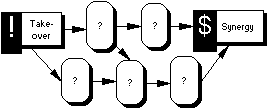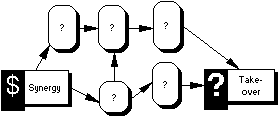


   |
process modelling |
 |
Process Descriptions - Synchronic versus Diachronicveryard projects > modelling > process modelling > synchronic / diachronic |
|
|
|
| Sequential. Task-oriented. | Parallel. Technique-oriented. |
| Concerned with progress through activities. | Concerned with the collaboration between activities. |
| Best described procedurally, in terms of sequence, selection and iteration. | Best described declaratively, in terms of objects and their responsibilities and exchanges. |
| Works best for describing individual scenarios. Totally generalized diagrams are usually too complex to read. | Works best for describing general rules. Detail can be encapsulated in subordinate diagrams. |
| Supports project management (i.e. project scheduling, task assignment, progress management, ). | Supports the management of capability (i.e. skills training, organization structures, standards, tools provision, ). |
| Measured using productivity and progress metrics | Measured using quality and service metrics. |
| Software methodologies - two perspectives |
 |
Process Modelling Patternsveryard projects > modelling > process modelling > patterns |
| Acqusition | Take-overs and mergers are carried out in order to achieve various forms of synergy. | |
| Benchmarking | System Performance | |
| Cost-cutting | What is below is decreased, to the benefit of what is above. |
 |
Acquisition and Synergyveryard projects > modelling > process modelling > patterns > synergy |
| From Take-over to Synergy | From Synergy to Take-Over |
|
|
|
 |
 |
| "Final cause" | added value of merged company |
| "Material cause" | synergetic resources (the loci of added value) |
| "Formal cause" | synergetic structures (the forms of synergy) |
| "Efficient cause" | synergetic activities (resulting in synergy) |
| Mergers and Acquisitions |
There are also some processes that focus on the processes themselves. These include model xyz, design xyz, improve xyz, simplify xyz, optimize xyz.
The opposite of simplification is "complication", adding new parts or concepts to a simpler system. This may be done for several reasons. For example, compare the dozens of dials, buttons, and switches in a modern airplane cockpit with the small number of controls in a World War I fighter plane, but then compare the speed, reliability, and safety of modern planes with those of sixty years ago. Complicating the cockpit was a trivial price to pay for the improvement. [Slobodkin, pp 6-7]
| L.B. Slobodkin,
Simplicity
and Complexity in Games of the Intellect
Cambridge MA: Harvard University Press, 1993 |
 |
 US
catalogue entry US
catalogue entry
includes note from author |
veryard projects is a technology consultancy, based in London |
|
|